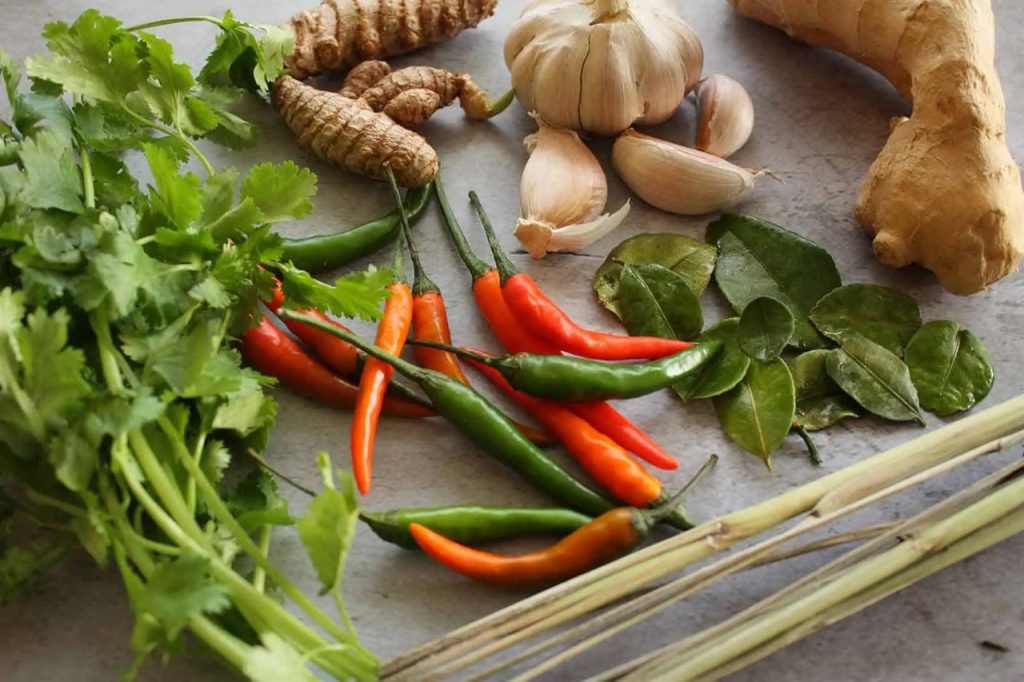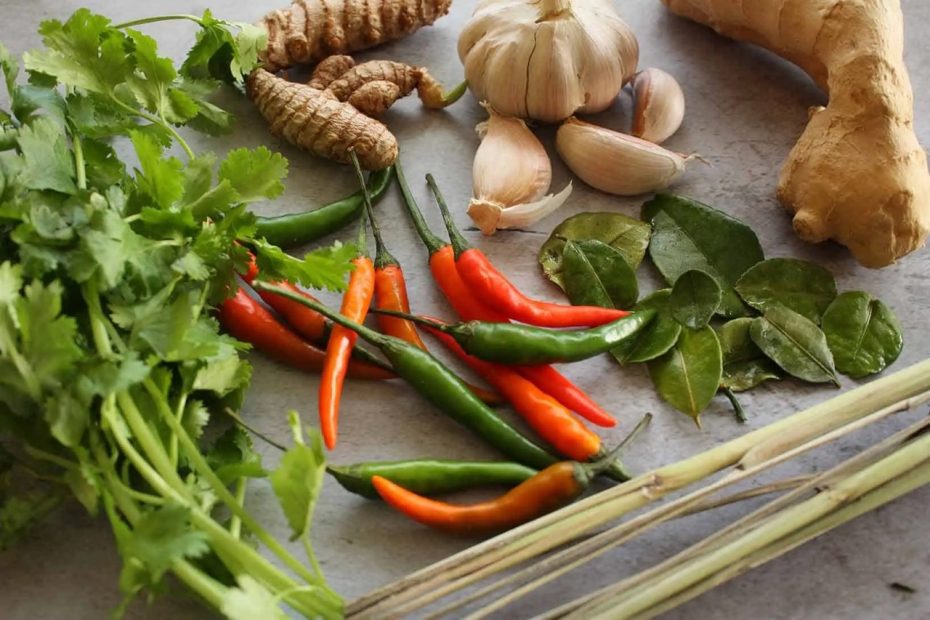Cambodian cuisine, also known as Khmer cuisine, is a tantalizing fusion of flavors, textures, and aromas that reflect the country’s rich history, culture, and natural resources. At the heart of this culinary artistry lies a plethora of ingredients that play a pivotal role in creating the unique and flavorful dishes that grace Cambodian tables.
In this article, you will explore the best Cambodian ingredients that are the essence of Khmer cuisine.
List of The Finest Cambodian Ingredients that Define Khmer Cuisine
Here are some of the best Cambodian ingredients you will commonly find in Khmer cuisine:
1. Rice (Bay): The Staple Grain
Rice holds a special place in Khmer culture and cuisine. As a staple food, rice is the foundation of many Cambodian meals. From simple steamed rice to the iconic Bai Sach Chrouk (pork and rice) and Nom Banh Chok (rice noodle dish with fish-based curry), rice is the canvas upon which the vibrant flavors of Cambodian dishes are painted.
2. Fish and Seafood: Abundant Aquatic Bounty
With its extensive coastline and numerous rivers, Cambodia enjoys an abundant supply of fish and seafood. These ingredients are at the heart of many traditional dishes like Amok Trey (steamed fish curry), and Prahok Ktiss (a fermented fish dip). The fish is often complemented by the use of fragrant herbs and spices, creating a harmonious blend of flavors.
3. Prahok: The Fermented Delicacy
Prahok, a fermented fish paste, is a unique and quintessential ingredient in Cambodian cuisine. It adds a rich umami depth to various dishes and sauces. Among its notable uses is the preparation of Prahok Kroeung, a flavorful paste used to season many dishes. The distinct taste of prahok is an acquired delight that exemplifies the complexity of Khmer cuisine.
You may check: Best Preserved Foods In Cambodia
4. Kroeung: The Aromatic Blend
Kroeung is a fragrant paste made by grinding together a variety of herbs and spices. This quintessential ingredient is the cornerstone of many Cambodian dishes, contributing depth and character. Comprising lemongrass, galangal, turmeric, garlic, shallots, and dried red chilies, Kroeung imparts a symphony of flavors that makes dishes like Amok and Samlor Kako truly exceptional.
5. Tropical Fruits: Natural Sweetness
Cambodia’s tropical climate blesses the country with a diverse range of succulent fruits. Mangoes, pineapples, bananas, and coconuts are commonly used in both sweet and savory dishes. The balance of sweet and tangy flavors from fruits adds complexity and freshness to Cambodian cuisine. Fruits are often incorporated into salads, desserts, and refreshing beverages.
6. Lemongrass: Citrusy Aroma
Lemongrass is a ubiquitous ingredient in Khmer cuisine, contributing its citrusy and fragrant aroma to various dishes. Used in soups, curries, and marinades, lemongrass enhances the overall taste profile and brings a delightful freshness to the palate. Its health benefits, including digestion aid and antimicrobial properties, make it a treasured ingredient.

Best Cambodian Ingredients In Khmer Cuisine From Thida’s Kitchen
7. Turmeric: Vibrant Color and Flavor
Turmeric, with its vivid yellow hue, not only imparts a warm color to dishes but also adds a unique earthy flavor. Often used in curries and rice-based dishes, turmeric is celebrated for its potential anti-inflammatory properties. It’s a key component of Kroeung, creating a flavorful base that characterizes many Khmer dishes.
8. Shallots
Shallots, a close relative of onions, are a fundamental ingredient in Khmer cooking. Their mild yet slightly sweet flavor forms the base for many Cambodian dishes, contributing a subtle depth to various sauces, stews, and curries. Finely chopped or blended into pastes like Kroeung, shallots are a crucial element that enhances the overall taste profile of Khmer cuisine.
9. Palm Sugar
Palm sugar, derived from the sap of palm trees, is a natural sweetener integral to Khmer cuisine. Its deep caramel-like flavor adds a rich sweetness to both savory and sweet dishes. Palm sugar is used to balance the tanginess of Cambodian soups and curries, and it’s an essential component of popular desserts like Num Ansom Chek (sticky rice cakes) and Kralan (bamboo sticky rice).
You may check: Best Cambodian Foods You Must Try
10. Garlic
Garlic’s pungent and aromatic qualities are used to infuse Cambodian dishes with its distinctive flavor. Often used in combination with other ingredients, garlic enhances the depth and complexity of dishes like Samlor Machu Ktiss (sour soup with fish) and Bai Sach Chrouk. Its potential health benefits and antibacterial properties add to its value in Khmer cuisine.
11. Star Anise
Star anise’s warm and licorice-like flavor is a staple in Khmer cooking, particularly in rich and hearty dishes like Saraman curry. Its unique star-shaped pods release a fragrant aroma when added to soups and stews, enhancing the overall taste with its aromatic notes.
12. Cinnamon
Cinnamon’s sweet and woody flavor adds warmth to Cambodian dishes, making it an essential component in both savory and sweet preparations. It’s used in Kroeung, where its aromatic presence complements the other spices. Cinnamon’s unique taste can be found in various curries, teas, and desserts.
13. Mint
Mint’s refreshing and cooling properties are cherished in Cambodian cuisine. It’s often used in salads, spring rolls, and refreshing beverages, offering a burst of freshness. Mint leaves are a common garnish in dishes like Lap Khmer, where they balance the flavors and add a delightful aroma.
You may check: Best Drinks In Cambodia
14. Sweet Basil
Sweet basil’s aromatic and slightly peppery flavor is a popular herb in Khmer cuisine. It’s used as a garnish and also incorporated into dishes like Khmer Fried Fish, where its vibrant green leaves add color and a hint of spiciness to the dish.
15. Kaffir Lime and Leaves
Kaffir lime’s distinctive flavor comes from both its zest and leaves. The leaves, with their aromatic and citrusy fragrance, are used to enhance the flavors of Cambodian curries, soups, and stews. They add a tangy depth to dishes like Somlar Machu Ktiss and Amok Trey.
16. Cilantro
Cilantro’s fresh and vibrant taste is a common garnish in Khmer cuisine. It adds a burst of color and flavor to dishes like Cambodian Grilled Beef and Green Mango Salad. Cilantro’s zesty notes complement the rich flavors of Cambodian cuisine.
17. Rice Paddy Herb
Rice paddy herb is a unique herb in Cambodian cuisine, often used in soups and salads. Its tangy and slightly lemony flavor adds a refreshing twist to dishes like Sour Soup and Fresh Spring Rolls.
18. Asian Coriander
Asian coriander, also known as Vietnamese coriander, has a peppery and citrusy taste that makes it a popular herb in Khmer cuisine. It’s used in various dishes, including soups and salads, to provide a flavorful kick.
19. Fishwort
Fishwort, with its subtle bitter taste, is used in Cambodian cuisine to add a hint of bitterness to certain dishes, often balancing out other flavors in a harmonious way. It’s commonly used in Samlor Kako and Prahok Ktiss.
20. Moringa
Moringa leaves are known for their nutritional benefits and are used in Cambodian cooking to add an earthy flavor to soups and stews. Moringa leaves are valued for their potential health benefits and nutrient-rich profile.
21. Noni Leaves
Noni leaves, though lesser known, are used in Cambodian cuisine for their unique flavor and potential health benefits. They are often incorporated into dishes to lend a distinct herbal note.
22. Kampot Pepper
Kampot pepper, renowned as one of the world’s finest gourmet peppers, hails from the picturesque region of Kampot in Cambodia. This exceptional pepper variety is cherished for its unique and complex flavor profile. With a delicate balance of fruity, floral, and slightly spicy notes, Kampot pepper adds a subtle yet distinctive touch to a wide array of dishes.
Cultivated using traditional and eco-friendly methods, the pepper’s distinct taste reflects the region’s rich soil and optimal climate. Whether used as a seasoning or a finishing touch, Kampot pepper elevates culinary creations, inviting taste enthusiasts to experience a truly exceptional flavor journey.
23. Khmer Chili
Khmer chili, a vibrant and integral element of Cambodian cuisine, imparts both heat and depth to dishes. With its fiery punch and subtle fruitiness, Khmer chili adds a layer of complexity that enhances the overall flavor profile of traditional Khmer dishes.
Whether used in spicy soups, stir-fries, or sauces, this chili variety offers a balance between intense heat and a hint of sweet undertones. Khmer chili embodies the bold and adventurous spirit of Cambodian cooking, delivering a dynamic and memorable culinary experience to those who savor its fiery allure.
You may check: Best Cambodian Snacks You Will Love
24. Ginger
Ginger, the aromatic and knobby root, holds a cherished place in cuisines around the world, including Cambodian culinary traditions. Its zesty and warm flavor profile adds a distinctive kick to a variety of dishes. In Khmer cuisine, ginger is a versatile ingredient, lending its unique essence to both savory and sweet creations. From hearty curries to soothing teas, ginger’s presence infuses Cambodian dishes with a comforting and invigorating quality. Beyond its culinary allure, ginger is also recognized for its potential health benefits, making it not just a flavor enhancer, but a treasure trove of wellness.
Final Thought
The exceptional ingredients that define Cambodian cuisine are a testament to the country’s natural resources and cultural heritage. From the humble rice to the fragrant Kroeung, each ingredient weaves its own tale of flavor, history, and tradition. As you explore the best Cambodian ingredients in Khmer cuisine, you’ll gain a deeper appreciation for the artistry and richness that make this culinary journey truly remarkable. Whether savoring the delicate balance of flavors in a seafood curry or enjoying the aromatic aroma of fresh lemongrass, every bite embodies the essence of Cambodia’s culinary excellence.



